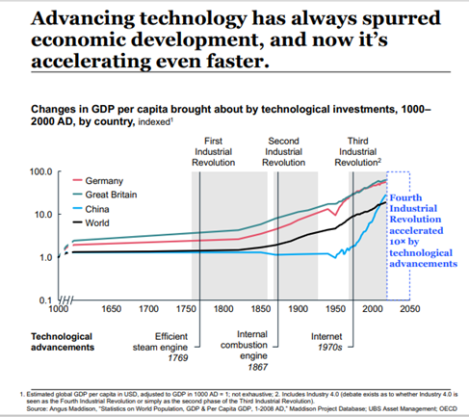Man has evolved from taking months or weeks to send a single letter via hand or messenger pigeon to speeding up the process with the invention of the telegraph, then the telephone, and finally, the smartphone of today. This...

Man has evolved from taking months or weeks to send a single letter via hand or messenger pigeon to speeding up the process with the invention of the telegraph, then the telephone, and finally, the smartphone of today. This transformation is one of many that underscore how emerging technologies have always been catalysts for global change, shaping our future in unprecedented ways.
As we study the impact, opportunities, and challenges presented by these transformative forces, we must also aim to steer these same forces and their resultant trends to our entrepreneurial advantage. These innovations are more than just novelties; they are the driving forces behind a global transformation.
At this point, it is important to note that change, especially transformational change, is often triggered by a crisis or key events. When we talk about crises in this context, we are not referring to global issues like the pandemic; instead, we are referring to the introduction of disruptive technologies within a company’s ecosystem. Disruptive technologies, such as artificial intelligence, can swiftly propel a company from one state to another, necessitating a transformation.
This transformative journey involves corporate restructuring, human capital transformation, and continuous learning. Corporate restructuring addresses financial crises, while human capital transformation focuses on changing mindsets and cultural elements.
This includes the incorporation of continuous learning as a part of the ongoing process aimed at making companies better at what they do. The evolution toward organisational learning and development is critical for sustained success.
Also Read: How digital payments are transforming the travel experience
Considering the untapped potential stemming from empowered new markets, revolutionised customer experiences, and leapfrogged production efficiencies, the unprecedented growth opportunities for a business are immense — but so are the challenges. In a world now characterised by Volatility, Uncertainty, Complexity, and Ambiguity (VUCA), navigating the technological landscape and its trends demands a strategic approach.
In fact, ignoring or delaying involvement with these advancements is not viable in today’s competitive landscape, if only because of how untenable this approach is in the long run. Companies that do not embrace these changes risk falling behind and facing regulatory issues. They also are in danger of being overshadowed by more tech-savvy and adaptable competitors and of compromising their global competitiveness in an interconnected, tech-driven economy.
Also, the dark side of disruption presents ethical, legal, and societal challenges that require responsible implementation. For example, companies will find themselves grappling with dilemmas related to privacy, data usage, and the potential consequences of their innovations on individuals and society.
At the same time, addressing these challenges is paramount to ensuring that technological progress aligns with ethical standards, legal frameworks, and positive societal outcomes. Naturally, balancing innovation and stability becomes a delicate act in this rapidly evolving technological environment.
Notably, the technology sector’s impact on global Gross Domestic Product (GDP) further serves as a testament to its relevance in the largest economies worldwide. For instance, in the United States, a whopping 24 per cent of economic growth comes from the technology sector.
This trend is not exclusive to developed countries; the tech sector contributes a whopping 16.34 per cent to the GDP of China. Even in countries like Singapore, where the economy is mostly service-based — i.e. more dominated by people than tech — technology continues to play a vital role.
The implications of this are profound. For industrialised first-world economies, technology is a major player, driving growth and innovation. However, for countries aspiring to develop similarly, access to importing or acquiring technology is the crucial factor. The ability to even enter the market for the adoption of new technologies can be a make-or-break factor for economic development.
Also Read: Why Singapore’s traditional sectors need a digital makeover
Delving into trend analysis is then pivotal for organisations, serving as a cornerstone in understanding the evolving narratives of emerging technologies and laying the groundwork for strategic planning.
Organisations armed with this analysis can, therefore, derive strategic responses, and engaging in trend analysis goes beyond staying current; it becomes a proactive initiative that empowers organisations to capitalise on opportunities and prepare for challenges associated with rapid technological adoption.
This awareness is not just for the corporate boardrooms; it is a call to action at the grassroots level, particularly within educational institutions. As we step into a future defined by emerging technologies, equipping the workforce with the knowledge and skills to adapt becomes paramount, too.
Colleges and educational institutions must curate awareness around these technologies, fostering an environment where future professionals are not just prepared for change but actively driving it.
In the grand tapestry of technological evolution, the narrative is not solely written by CEOs and executives; it is co-authored by the workforce, the students, and the educators.
The transformative potential of technology is a shared responsibility, and as we navigate this tech revolution, let us ensure that no one is left behind. Only a collaborative effort, fuelled by awareness and education, will truly unlock the global change promised by emerging technologies.
—
Editor’s note: e27 aims to foster thought leadership by publishing views from the community. Share your opinion by submitting an article, video, podcast, or infographic
Join our e27 Telegram group, FB community, or like the e27 Facebook page
Image credit: Canva
The post Tech revolution unleashed: Navigating emerging trends for strategic transformation appeared first on e27.











